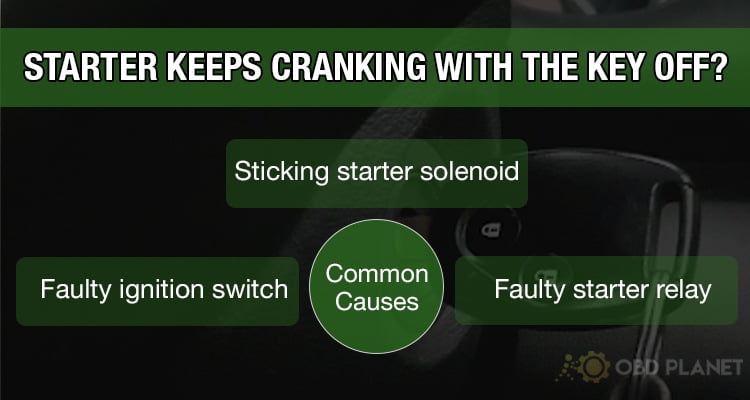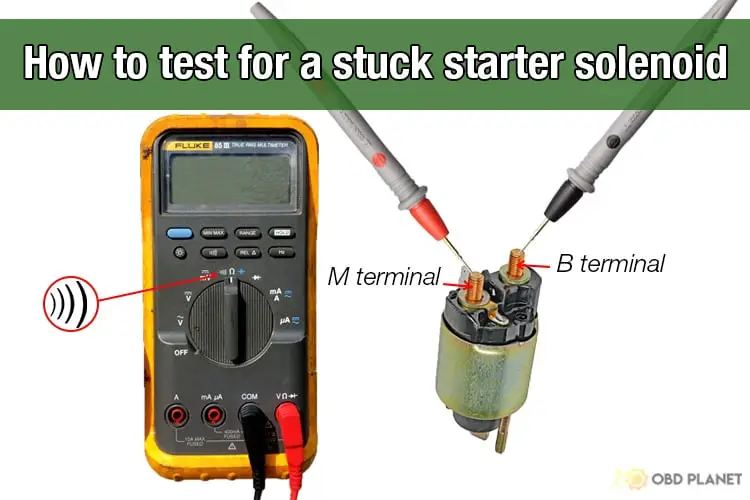Your starter keeps cranking after the engine has already started. Even when you turn the key off, take it out; the starter still engages.
Ok, now is the time to panic. Remove your battery cable immediately, and then the starter will stop. You must do it because the starter motor is only designed for intermittent use as it is very powerful yet compact.
This problem is commonly found in Ford vehicles. And there are a few causes for this, but the good news is they will be an easy fix.
First thing first, let’s do some diagnosis.

Bad ignition switch/Starter delay
Let’s just say the solenoid is good. The first scenario you have to think of is either the ignition switch or the starter relay is bad.
How to test?
1. Find the starter solenoid.
Start from the battery, follow the biggest cable. And you will find the starter solenoid. In some cars, the solenoid is mounted to the starter. In other vehicles, it is on the firewall.
No matter where they are, their function and the way to diagnose are the same.
So don’t be confused.
2. Remove the S wire from the starter solenoid

3. Put the test light on the S wire
You’ll need an automotive test light for this step. First, connect the clip end to the battery negative terminal. Use the probe end to connect to the S wire you’ve just removed.
Next, have someone turn the key to “Start.”
The light will come on when the key is at “Start.” It should go out when the key is in the “Run” or “Off” position.
If the light doesn’t go out, either your ignition switch or the starter relay has malfunctioned. So, they continuously provide power to the solenoid, which keeps the starter cranking.
Now, the question is, which one?
It really doesn’t matter. There are three reasons you should replace the starter relay first:
- It’s very likely to be the case
- The part is very cheap (about ten bucks)
- It takes you 10 minutes to replace.
How to replace a starter relay
Step 1: Disconnect the battery
Step 2: Find the starter relay
First, you need to locate the Power Distribution Center (PDC) in your car. Google this keyword: “{Your car model, year} fuses and relays.” You will find the PDC and the starter relay location.
Step 3: Buy and install a new starter relay.
There is a part number on the old starter relay. Use that number to buy a new one. To place it, simply remove the old relay and push the new one back on.
Step 4: Reconnect the battery and check if the problem persists or not.
How to replace an ignition switch
If replacing the starter relay doesn’t solve the issue, the next thing you should do is to replace the ignition switch. Again, this will not be difficult and here’s how you can do it yourself:
Stuck starter solenoid
Back to the test above, if the test light goes out when the key is not in the “Start” position, that eliminates some possibilities, and a stuck starter solenoid is the next thing you have to inspect.
How to test for a stuck starter solenoid?
Step 1: Find the starter solenoid and remove it.
As I mentioned before, start from the battery; just follow the biggest cable. And you will find the starter solenoid. Remove it using a ratchet.
Step 2: Check for continuity using a multimeter.

First, put the black lead into the COM jack, the red one into the VΩ jack.
Next, turn the switch to the continuity symbol (it looks like a wifi symbol).
Connect the test leads to the two bigger terminals on the solenoid. If you hear a “beep” sound, a stuck starter solenoid is your problem. Replace it, and you’re good to go.
Before we get to the how-to-replace part, let’s understand the physics.
Understand the test
“The two bigger terminals” I mentioned above is actually called:
- B terminal (connected to the battery)
- M terminal (connected to the starter)
When you turn the key to “Start,” the power will flow to the starter solenoid (via the S terminal). This power will activate the magnetic field, which pushes a contact ring inside the solenoid. The contact ring will close the circuit (by connecting the B and M terminals) and allow the starter motor to spin.
Small tips: That’s why you can jump a starter using a screwdriver to connect B and M terminals
This contact ring could be welded to the circuit due to intensive heat, causing the B and M terminal to connect permanently. And that’s when the starter solenoid becomes stuck.
The continuity test will tell you if the circuit is closed or not. In other words, the circuit allows electricity to flow or not. By testing the continuity of B and M terminals, you’re testing whether the contact ring is welded.
How to replace a sticking starter solenoid
Once you take the solenoid off for the continuity test, replacing it will be pretty straightforward.
Just bring the old solenoid to the nearest auto shop, buy the same part, and put it on. This video will show you how to replace a starter solenoid properly.
Conclusion
With the solutions I provided above, there are 95% chances that you will fix the problem. However, in some rare cases, the problem lies within the starter itself or the wiring. In either of those cases, you need to bring your car to the dealer as the causes can be pretty sophisticated to diagnose.
Finally, if you have any problems, don’ forget to leave a comment below. I’m always here to help!



